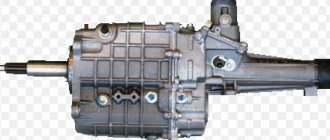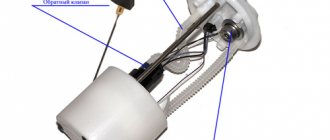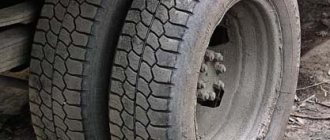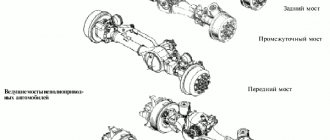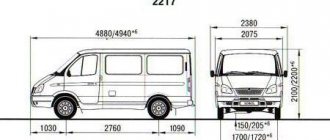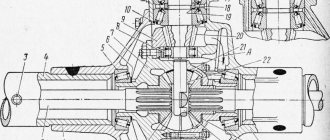History of creation
The Gazelle series cars first rolled off the assembly line of the Gorky plant on June 20, 1994. The light-duty vehicle belongs to class N1 (M1) with a permitted load capacity of no more than 3.5 tons. In the winter of 2003, the Gazelle brand received its first restyling. The updated version had a modified radiator grille, a new bumper and optics. In the summer of 2005, the number of Gazelle cars produced exceeded 1 million.
In February 2010, a secondary restyling was carried out, and a qualitatively new variation of Gazelle Business was released. Just a few years later, in 2013, production of the next generation of Gazelle Next cars starts. The old model inherited an old frame, an unchanged rear axle and a reliable gearbox.
Appearance of Gazelle Next
What kind of beast is “all-wheel drive”
There is a special design of the car transmission that makes it possible to transmit torque to all wheels at once. All-wheel drive layouts vary depending on the vehicle design:
- Classic - in this version the engine is placed longitudinally. It is transmitted through the intermediate driveshaft to the transfer case. In some cases, the transfer case may be in the same block as the gearbox. From the transfer case, cardan shafts transmit torque to the drive and rear axles of the car.
With this design, the middle axle remains through, and a driveshaft goes from it to the rear axle. - Based on front-wheel drive - in the case of front-wheel drive passenger cars, models with rear axle drive are produced. A power take-off gearbox to the rear axle is additionally installed in the standard box. The differential lock is located in the gearbox housing.
- With a rear engine - the rear-engine layout provides the main drive to the rear axle, the main gear goes along with the gearbox. The drive is switchable or permanently switched on.
All-wheel drive schemes:
- Plug-in all-wheel drive is the simplest scheme in which torque is transmitted to only one axle, the second is connected only when necessary using a transfer case.
Gazelle all-wheel drive diagram
The obvious advantages of permanent all-wheel drive are the “indestructible” design and the ability to drive with all-wheel drive both on asphalt and off-road. Among the disadvantages, you should pay attention to increased fuel consumption, complexity of setup and increased weight.
Role of the unit
The 4x4 transfer case is responsible for distributing forces on all drive axles of the vehicle. Its additional application is starting and stopping the drive front axle. Basically, a gazelle of this type is characterized by a two-stage gearbox. Its operation affects the gear ratio, as a result, the number of gears doubles.
When starting a direct transmission on a 4x4 gazelle, the first row of gear ratios is introduced, and when downshifting, the second row is introduced. This factor determines the vehicle's travel in a variety of road conditions.
The all-terrain Gazelle is characterized by a design that blocks the possibility of downshifting when the front axle is engaged. A device of this type makes the rear axle insensitive to large torque overloads.
Design of a 4x4 transfer case for a Gazelle
Gazelle modifications
The main characteristics of the Gazelle, which has all-wheel drive, imply the use of a transfer case with a center differential equipped with a lock, a front axle with a universal joint and larger tires with a modified tread for maximum cross-country ability. At the moment, the all-wheel drive Gazelle has several modifications:
- four-wheel drive vans;
- four-wheel drive minibuses;
- onboard all-wheel drive Gazelles.
The layout of the main components in all modifications has not undergone major changes. Onboard Gazelles with all-wheel drive are perfect for commercial organizations whose cargo does not require careful transportation. Unlike the version with an awning, flatbed vehicles do not have a built-in frame, which allows them to transport large loads. Depending on the modification, the sides can be either stationary or movable. The absence of a body simplifies the process and speed of loading and unloading goods.
All-wheel drive minibuses are an ideal option for transporting passengers with equal opportunity to be used for transporting oversized and light cargo. The seating arrangement inside the cabin may vary.
The car is equipped with a wide wheelbase and tires with a modified tread, so the car turns into a mini all-terrain vehicle.
Diagram of the wheelbase of the all-wheel drive Gazelle
You can order a Gazelle for transporting chilled and frozen products, a body with a thermal unit, and even a special van for delivering bakery products. Any Gazelle with all-wheel drive from the model range fully meets the stated characteristics and easily copes with the assigned tasks.
The vast experience that the Gorky Automobile Plant has accumulated and an affordable price on the market make the Gazelle models competitive in the market with cars of the same class.
The GAZelle Business 4x4 all-wheel drive van is a unique creation of the Russian automobile industry. First of all, because this car has practically no competitors in our market. Imported analogues with a 4x4 wheel arrangement are an order of magnitude more expensive and do not in any way qualify as a budget van. And although the Ulyanovsk “loaf” will give a head start to any SUV, it is still morally outdated, and comparing it with the “GAZelle 4x4” is not entirely correct. Therefore, when the question of finding an all-wheel drive “rival” arose before the Nizhny Novgorod test, it turned out that the only competitor of the GAZelle was its younger brother – the Sobol-Business 4x4 van.
The first thing that catches your eye when examining Nizhny Novgorod vans with the prefix “business” is the good build quality of production vehicles. Improvements can be noticed even when approaching the car. If previously the gaps between the fenders, hood, headlights or bumper “danced” as they wanted, and from different sides of the car could differ by almost a centimeter, now the quality of fitting of parts has noticeably improved. The gaps have become even and neat, making the cars look “tight.” The design of the sliding door has also been improved; now it closes easily and tightly, leaving no gaps. Such precision adorns Gorky vans even more than the updated design.
“All the best for children”
The interior of the GAZelle has also noticeably changed (it is almost no different from the sable one). The new dashboard, designed by EDAG, looks nice. Plastic of two colors is pleasant to the touch. The quality of finishing materials has been brought up to that of Korea, which is a definite plus in the case of Nizhny Novgorod vans. The instrument cluster with silver “wells” is laconic, but the readings are easy to read both in daylight and at night - the driver has the ability to adjust the intensity of the instrument illumination. The new steering wheel has a comfortable grip and is equipped with radio control keys. Yes, yes, I was not mistaken. As standard, vans are equipped with an MP3 player with a USB input for a flash drive. This is an attraction of unprecedented generosity! Not to mention the electrically heated mirrors.
The seven-seat cargo-passenger Sobol is equipped with an additional heater for second-row passengers. Now the frosts are not scary. In summer, you can create a comfortable microclimate in the rear with the help of sliding windows and an additional sunroof.
Now about the disadvantages. They are not so significant, but the overall positive impression is somewhat blurred. First of all, the flimsiness of some parts is surprising. For example, retractable cup holders are made of small plastic parts that fall apart the first time they are used. In our test, the cup holder couldn't handle a half-liter bottle of water and broke within a few hours. It's a shame? Certainly.
A similar situation with the ashtray. It is made more for show and in the open position is completely non-functional. Cigarette butts will simply fall out as you go. A small thing, but unpleasant.
The passenger sofa also remained unchanged. The back of the sofa is not adjustable and is located almost vertically. On a long journey this creates a lot of inconvenience. And if the driver’s seat can be called comfortable, then you won’t envy your fellow travelers. Moreover, part of the passenger legroom is eaten up by archaic downshift levers and differential locks. Not only are they inconvenient to use, but they also interfere with the second passenger.
Van technical characteristics
| Parameter | "Gazelle-Business" GAZ-27057-288 | "Sable" GAZ-27527-298 |
| Wheel formula | 4x4 | |
| Number of seats in the cabin, persons. | 3 | 7 |
| Own weight, kg | 1960 | 1990 |
| Load capacity, kg | 1540 | 810 |
| Body volume, m 3 | 9 | 3,7 |
| Engine | UMZ-4216 | UMZ-4216 |
| Maximum power, hp | 107 | |
| Maximum torque, N.m | 220 at 2500 min -1 | |
| Transmission | 5-speed, manual | |
| Transfer case | 2 gears, manual | |
| Differential | Bevel, gear | |
| Suspension | Dependent, spring | |
| Tires | 185/75 R16 | |
Eh, roads...
We've studied the theory, looked around the cabin, and it's time to go free. Let me remind you that our test included vans with permanent all-wheel drive “Gazelle” GAZ-27057-288 and “Sobol” GAZ-27527-298. And if upon initial inspection these cars are almost identical, then in motion the “all-wheel drive” vehicles are significantly different, even though both cars have a similar gross weight (the GAZelle Business is only 30 kg lighter) and are equipped with the same UMZ-4216 engines.
The gasoline engine produces 107 hp. For dynamic driving in a rear-wheel drive GAZelle, it is quite enough, but in the 4x4 version, things are different. All-wheel drive simply eats up some of the power, and the GAZelle 4x4 accelerates slowly and laboriously. The engine has to be cranked to the “red zone” and only then switched. The noise of the transmission is constantly annoying, which appears already at a speed of 40–50 km/h. In general, the GAZelle’s permanent all-wheel drive has completely discredited itself on asphalt. I honestly didn't like the car while driving, and the only fault was the old transmission.
In Sobol, the load on the all-wheel drive system is also high, but the car obediently responds to pressing the gas pedal, the hum of the axles and transfer case appears only after 80 km/h - for an untested domestic all-wheel drive, this is a good result. The engine easily spins up to 4000 rpm, and if desired, you can speed up the Sobol. The payload of a van with a single tire tire is only 800 kg, so we can say with confidence that the power of the Euro 3 UMZ-4216 engine is quite enough for the Sobol.
There are other significant differences between the Nizhny Novgorod “brothers”. Despite all-wheel drive, the Sobol retained a large turning angle of the front wheels and was convenient to maneuver, which cannot be said about the GAZelle 4x4, which has a turning circle of 15 m versus 12 m for the Sobol. At the same time, the wheelbase of the latter is shorter by only 14 cm.
GAZ-33027 - video of off-road driving
As a result of the introduction of the front drive axle and transfer case into the design, the curb weight of the vehicle increased and, compared to the base model GAZ-3302, the load capacity decreased by 250 kg. The car is equipped with a mechanical five-speed synchronized gearbox and is equipped with a working dual-circuit brake system with a hydraulic drive and a vacuum booster; The front brakes are disc, the rear are drum. The GAZ-33027 is equipped with a four-cylinder ZMZ-4026.10 or ZMZ-4063.10 engine with a displacement of 2.445 liters and a power of 100 hp. With. The maximum speed of the car is 110 km/h.
For revision
Gorky light-duty trucks generally create a good impression. Intelligent improvements and changes in design allow us to hope for a bright future for “gas” vans. I liked the torquey engine and the modified gearbox.
Another question is the 4x4 versions of GAZelle and Sobol. Permanent all-wheel drive noticeably interferes with the cars' operation. They became heavier and clumsier. The constant noise from the transmission is annoying. And the cross-country ability of light-tonnage vehicles is not impressive. Perhaps it's time to abandon the old "Soviet" transfer case and look for a worthy imported replacement. In the meantime, it’s better to be content with the rear-wheel drive versions of the GAZelle and Sobol.
"GAZELLE" COUNTRY
VARIATIONS ON THE THEME
To reduce the cost of an all-wheel drive truck, it uses a minimum of original
Igor TVERDUNOV, Anatoly KARPENKOV. Photo by Igor Tverdunov
It has long been known that in the vast herd of gazelle modifications there are all-wheel drive individuals. Only this “beast” is rare: few have seen it, and some have never heard of such a miracle of technology. Only in recent months have Gazelle and all the leading vehicles become more common on the roads. Maybe the crisis forced the price to be reduced, maybe for some other reason - in short, over the past year, 1998, GAZ assembled 750 of these cars, almost half of what has been produced since 1995, when they made the first all-terrain lorry.
CHEAP BUT ANGRY
This is roughly how one can formulate the “ideology” of Nizhny Novgorod cars. It’s unlikely that anyone would argue that in terms of technical excellence and quality, the Gazelle is not “ahead of the rest.” However, in poor Russia, the best advertising is price. But in order not to give up occupied positions, not to give in to competitors, cheapness alone is not enough. The car must be improved, acquired modifications, and become more reliable at the same time. stay cheap.
How to turn an ordinary rear-wheel drive truck into an all-terrain vehicle? It’s very simple if you follow the Nizhny Novgorod recipe. An ordinary Gazelle is taken, to the frame of which modified spring brackets are attached. This allows you to raise the car by 70 mm and expand the spring track of the front axle. In addition, a cross member is added to the frame to accommodate the transfer case.
The “handout” itself is original. It was not possible to find a ready-made one, so we had to develop it again. This work once again showed what difficulties can be encountered when creating a new unit from scratch. There were problems with the transfer case, but today, according to factory specialists, they were solved, and now the design is fully functional.
The cardan shafts were made using standard crosspieces, and the same springs were installed in front as in the rear. The middle part of the front drive axle, together with the gearbox, was unified with the rear one, of the old design. The fact is that now the rear axle beam of the Gazelle is welded, but at first it was composite - stockings were pressed into the gearbox housing. It is this design that is taken as the basis for the front drive axle.
But ordinary cardan joints instead of CV joints in the drive of the front wheels surprised us at first: theory says that this cannot be done. It turns out that if you really want (or rather, really need to), then you can. And without noticeable unpleasant consequences. But more on that later.
So, we changed the spring mounts, installed a transfer case, a front drive axle, new driveshafts (the front and rear driveshafts are the same) - and now the all-wheel drive version of the Gazelle is ready.
The simplicity of the design and the widespread use of standard components and assemblies make it possible to easily “square” any Gazelle into an all-terrain vehicle using the 4x4 formula, from a flatbed truck to a bus, and at the same time maintain an acceptable price. In March, a flatbed vehicle with all driving wheels cost 80 thousand rubles, a seven-seater van - 115 thousand, and a thirteen-seater bus - 141 thousand.
LETTING OFF THE ASPHALT
The people have mastered the Gazelle. I appreciated the advantages and learned to deal with the shortcomings. But this machine has one problem that cannot be easily dealt with. Created as a car for asphalt, the Gazelle is completely helpless when it comes to driving through sand or loose snow, and has difficulty overcoming ice. To expand the scope of application of the machine, we developed a modification with all drive wheels.
Regular operation
The 4x4 transfer case for a gazelle is characterized by operating modes:
- Turning on neutral.
Further modes are focused on the differential.
- Its unlocking is conditional on the overdrive being engaged. The torque division has the form of a 1:2 ratio.
- Locking with the condition that overdrive is engaged. The division of torque depends on the traction of the wheels and the surface.
- Unlocking with downshift enabled. Torque distribution is represented by a 1:2 ratio.
- Blocking with the condition that downshift is enabled. Torque distribution is carried out depending on the adhesion of the tires to the surface. The functioning of the front and rear axles is characterized inextricably. This mode has the highest degree of cross-country ability.
